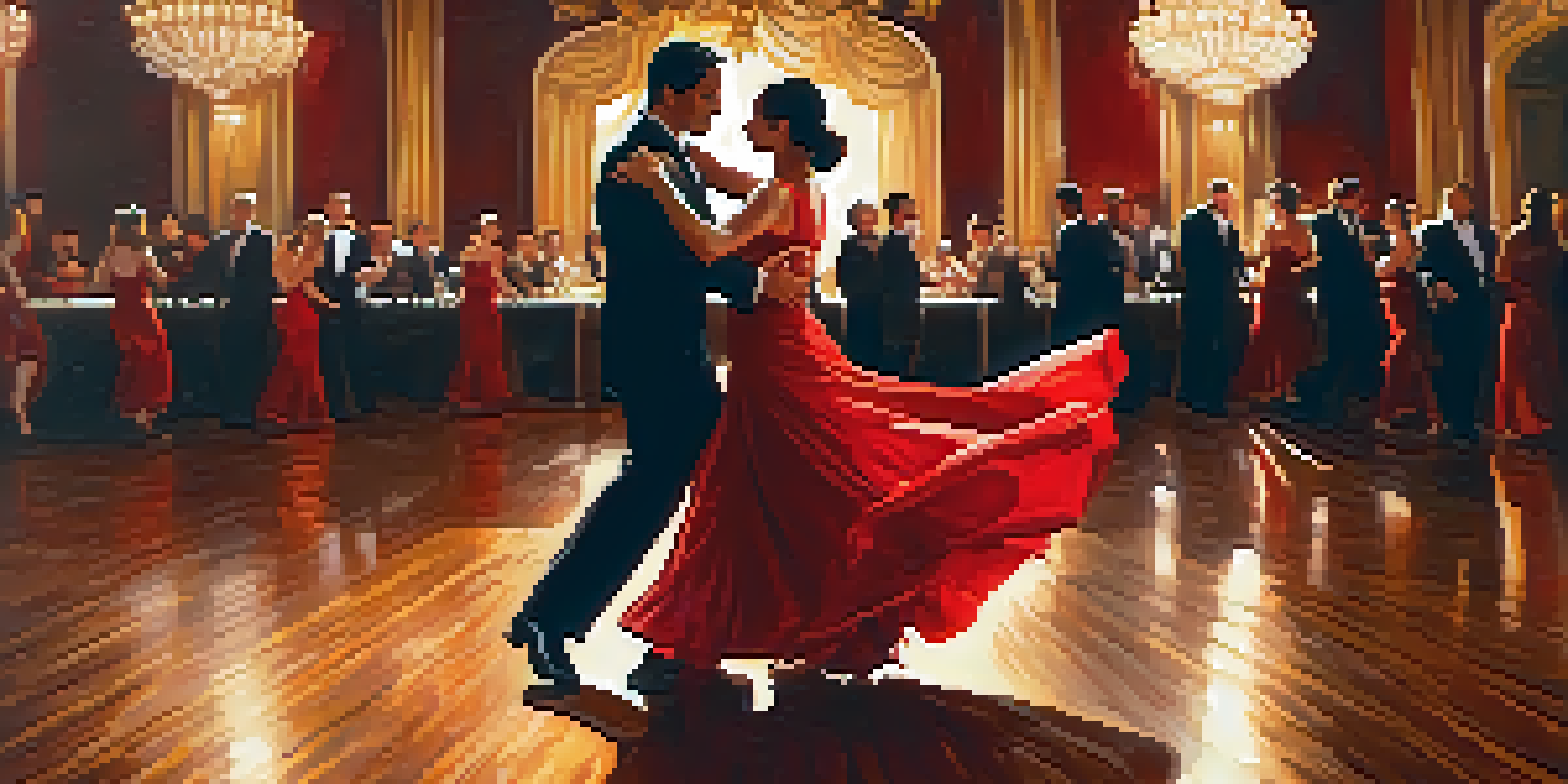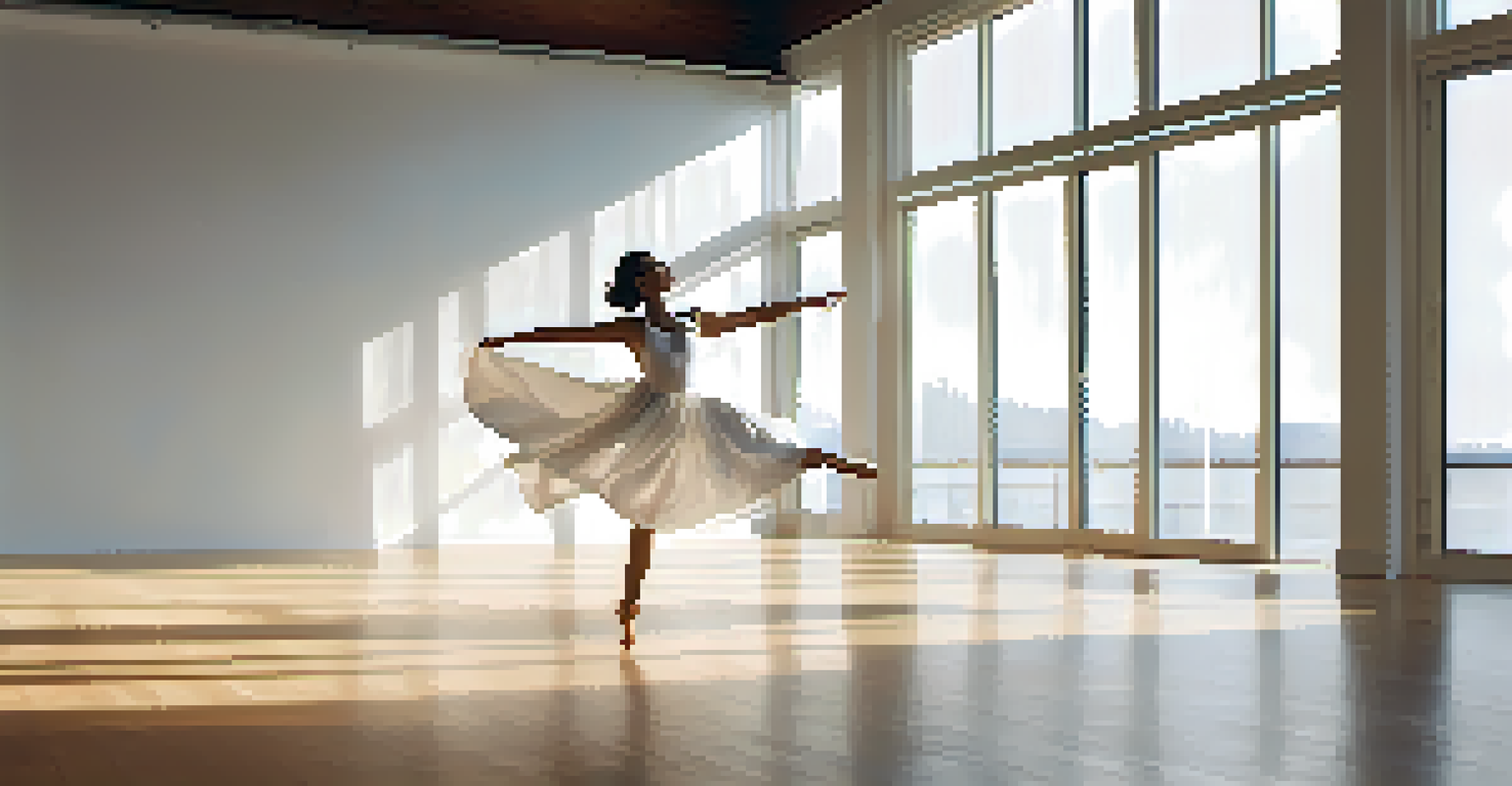Translating Emotion: The Role of Dance in Nonverbal Communication

Understanding Nonverbal Communication Through Dance
Nonverbal communication is all around us, from the way we gesture to how we position ourselves in social settings. Dance, as a form of nonverbal expression, transcends spoken language and connects people through shared emotions. For instance, a simple sway of the hips or a graceful leap can convey feelings that words often struggle to articulate.
Dance is the hidden language of the soul.
When dancers perform, they tap into emotions that resonate with their audience, creating a shared experience that can be both intimate and universal. This is why dance is often used in storytelling—whether in ballet or contemporary styles, the movement becomes a powerful medium for expressing complex feelings. Think of how a poignant solo can evoke empathy without a single word being spoken.
By observing the nuances in a dancer's movements, we can interpret feelings such as joy, sorrow, or anger. This ability to read emotions through dance highlights its role as an essential component of our emotional vocabulary, enabling connections that might otherwise go unformed.
The Emotional Palette of Dance Styles
Different dance styles carry unique emotional weights, allowing for varied expressions of feelings. For example, a passionate tango can express intense romance and longing, while a lively salsa might convey joy and celebration. Each style has its own vocabulary of movement, which can evoke specific emotional responses from both the dancer and the audience.

Moreover, the cultural backgrounds of these dance forms enrich their emotional context. A traditional Indian Kathak performance, for instance, tells a story through intricate footwork and facial expressions, often rooted in historical narratives and spiritual themes. This cultural layering adds depth to the emotional journey experienced by the viewers.
Dance as Nonverbal Communication
Dance transcends spoken language, allowing for deep emotional expression and connection among audiences.
Understanding the emotional palette of various dance styles can enhance our appreciation for the art. It invites us to explore how movement, rhythm, and music converge to create a symphony of feelings that resonate deeply within us.
Body Language: The Silent Communicator
Body language plays a crucial role in how we interpret emotions during a dance performance. Dancers use their entire body to convey subtle cues—whether it’s the tilt of a head, the extension of a hand, or the arch of a back. These movements act as a silent language, speaking volumes without uttering a single word.
Dancing is like dreaming with your feet!
For instance, a dancer may lean forward to express eagerness or pull back to indicate hesitation. These physical manifestations of emotion guide the audience’s understanding, allowing them to relate on a personal level. This innate ability to interpret body language is something we all share, making dance a universally accessible form of communication.
Moreover, the connection between dancers can amplify this nonverbal dialogue. The way two dancers interact—through partnering or choreography—can illustrate themes of trust, conflict, or harmony, enriching the narrative being performed and drawing the audience into the emotional core of the piece.
The Role of Music in Dance and Emotion
Music and dance are inseparable partners in the world of expression, each enhancing the other’s emotional impact. The rhythm, melody, and dynamics of music can elevate a dancer's performance, helping to convey feelings more vividly. For instance, a slow, haunting melody can lend a sense of melancholy to a contemporary dance piece, while an upbeat tempo can encourage lively, joyful movements.
Additionally, the use of specific musical genres can evoke distinct emotional responses. Classical music often inspires elegance and grace in ballet, while hip-hop beats can invoke energy and spontaneity in street dance. This synergy between music and movement creates a powerful emotional experience for both the performer and the audience.
Cultural Influence in Dance Styles
Different dance styles embody unique emotional weights and cultural narratives, enriching the viewer's experience.
The interplay of music and dance serves not only to express emotions but also to evoke them. When we hear a familiar tune accompanying a dance, it can trigger memories or feelings that resonate with our personal experiences, making the performance even more impactful.
Dance as a Tool for Healing and Expression
Dance is increasingly recognized as a therapeutic tool, helping individuals express emotions that might be difficult to convey verbally. Dance therapy, for example, harnesses movement to promote emotional release and healing, enabling participants to explore their feelings in a safe environment. This is particularly beneficial for those dealing with trauma or grief, as movement can serve as a vehicle for processing complex emotions.
Moreover, engaging in dance allows individuals to connect with their bodies and emotions on a deeper level. It encourages self-expression and body awareness, fostering a sense of empowerment and confidence. As participants move, they can discover new ways to communicate their thoughts and feelings, facilitating personal growth and understanding.
Through this lens, dance becomes not just an art form, but a vital means of emotional expression and healing. It reminds us that our bodies have stories to tell and emotions to share, often in ways that transcend conventional language.
The Impact of Social Dance on Community and Connection
Social dance forms, like salsa, swing, or line dancing, emphasize community and connection, allowing people to share emotions collectively. These dance styles create a sense of belonging, fostering relationships among participants through shared experiences on the dance floor. The joy of moving together, reacting to the music, and responding to each other’s movements can strengthen social bonds.
Moreover, social dance acts as a form of nonverbal communication that transcends language barriers. In a diverse dance setting, individuals from various backgrounds can connect through the universal language of movement, expressing shared joy or excitement without needing to speak the same language. This creates an inclusive environment where everyone can participate and express themselves.
Dance Therapy and Healing
Dance serves as a therapeutic tool, enabling individuals to express complex emotions and foster personal growth.
In essence, social dance serves as a powerful reminder of our innate desire for connection. It highlights how movement can bring people together, creating a tapestry of shared emotions and experiences that enrich our social fabric.
The Future of Dance as a Communication Medium
As we look to the future, the role of dance in nonverbal communication is likely to evolve with technological advancements. Virtual reality and digital platforms are already allowing dancers to reach wider audiences, enabling new forms of expression and connection. This could open doors for innovative ways to convey emotion, bridging gaps between cultures and communities.
Moreover, as society becomes more aware of the importance of emotional intelligence, dance may play an even bigger role in promoting understanding and empathy. Educational programs that incorporate dance could help individuals express their emotions more effectively, fostering healthier communication skills in various settings.

Ultimately, the future of dance as a communication medium holds exciting possibilities. It reminds us that emotions are a fundamental part of the human experience, and dance can be a powerful tool for expressing and sharing those feelings in an ever-evolving world.